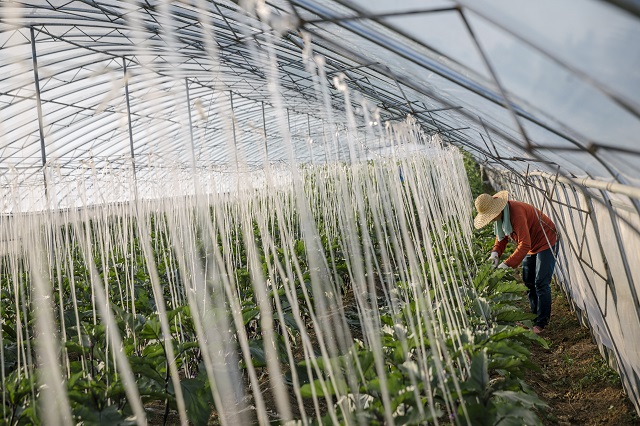
A farmer tends to plants in a greenhouse at the Shared Harvest farm, a 66 acre community-shared organic farm in the Tongzhou and Shunyi Districts of Beijing, China. Photo by Panos Pictures/Food and Land Use Coalition
This commentary explores the social and economic benefits that climate action can deliver and uses real world examples to show how these benefits can be used to further equity and ensure a just transition to a new climate economy.
In December 2015 world leaders held hands on a stage in Paris, united in their commitment to limit global temperature rise to below 2°C (3.6°F) and ideally to 1.5°C (2.7°F). The Paris Agreement remains the world’s best shot at avoiding runaway climate change. Implemented wisely, it can also unlock the inclusive growth story of the 21st century, improving lives around the world.
The economics of climate action have improved dramatically since then. Solar and wind power are now cheaper than coal and increasingly cheaper than natural gas. Electric vehicle technology has improved so quickly that some major automakers are planning to stop making internal combustion engines. Knowledge about how to sequester carbon in trees and soil, as well as industrially, is advancing rapidly. Climate solutions are cheaper and more available than ever before.
At the same time, the urgency of the climate crisis is even more stark today. More frequent and severe wildfires, storms, and record heatwaves are devastating communities. In the first half of 2019 such events displaced a record 7 million people. Climate change is disrupting lives and livelihoods, with the poorest hit hardest. New studies show that even half a degree of warming can lead to millions more people being impacted and much greater economic damage. Inaction, or inadequate action, will mean more lives lost, mass migration, major economic disruptions and worsening inequality.
The growing urgency of the climate crisis and the more favorable economics of climate action together show the dire need and the incredible opportunity for bold climate action. It is increasingly clear that low-carbon and resilient economic growth can be an engine to help revitalize global growth, contribute to poverty reduction, generate jobs and income opportunities, all while vigorously countering growing climate risks (see Box). And the public is waking up to the urgency and the opportunity of action: more than 7 million people in 185 countries took to the streets last September to demand that their governments step up climate action.
But there is resistance from vested interests in the old economy. That resistance is quick to latch on to the limitations of any climate policies that do not put people first.
Where there are genuine concerns by citizens, these can and must be addressed. Social unrest in France, Chile, Ecuador and elsewhere has shown that climate action is only politically viable if it delivers clear benefits to the vast majority of people now, and it cannot leave vulnerable communities or workers behind. To be politically viable, corrective measures must accompany any policies that may place a higher burden on low- and middle-income households.
The process of developing and implementing these policies is just as important. A transparent and deliberative process can help identify political and material risks, improve communication between decision-makers and the public, and give agency to socially and economically marginalized groups. Fortunately, there is ample evidence showing that policies that address climate change, developed through inclusive processes, can also deliver immediate benefits to people. We call this people-centered climate action.
People-centered climate action does three things: through an inclusive process, it purposefully identifies and unlocks social and economic benefits, it targets these benefits to further equity, and it ensures a just and well-managed transition away from a high-carbon economy. Examples of people-centered climate action include using the revenues from carbon pricing or savings from cuts in fossil fuel subsidies to support low-income or vulnerable communities, employing innovative financing to boost energy access through distributed solar power, and restoring ecosystems in ways that also raise rural incomes.
The transition to a low-carbon and climate resilient economy is starting. The finance sector is waking up to the risks of high-carbon and stranded fossil fuel assets, and is rapidly shifting away from them toward green alternatives. Over 700 major businesses have committed to science-based targets for emissions reductions, with many now aiming for net-zero emissions by 2050. Over 100 cities have committed to net-zero targets. Investors are considering how their actions can support, rather than hamper, inclusive development and a just transition. These private sector and sub-national leaders are now calling on national governments to follow their lead.
Some governments have committed to mid-century net-zero emission goals, and so far 68 countries have indicated that they will enhance their Paris Agreement targets in 2020. But these countries are mostly smaller economies, often those most vulnerable to climate impacts, and together are responsible for only 8% of global emissions.
Leaders of some of the world’s major emitter economies are hesitating at a time when they should instead be accelerating action. Amidst signs of a global economic slow-down, some leaders are falling back on outdated notions that there is a trade-off between climate action, on one hand, and economic and social progress, on the other. Those resisting the low-carbon transition are quick to resurface these notions.
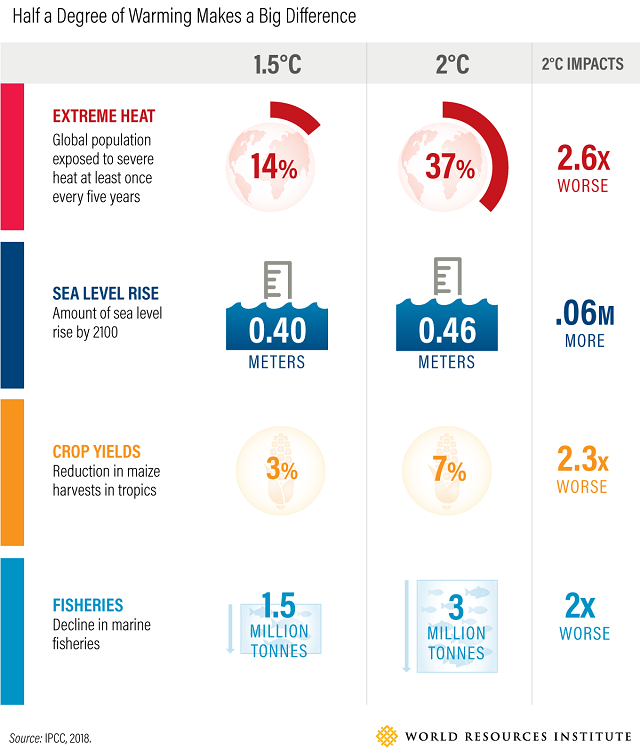
But as the global transition to a new climate economy progresses, the political and policy grip of those with vested interests in the old economy, such as the fossil fuel sector, will wane. They will increasingly be counter-balanced by voices from the new climate economy – solar companies and consumer goods companies committed to deforestation-free supply chains, for example.
Central to this rising chorus are the youth and voting public demanding climate action. People around the world are also crying out for more equal access to decently paid jobs, for health care and education, and for a better future for their children.
The world now stands at a crossroads. We can, and must, deliver both ambitious climate action and better lives for people. And there is no viable alternative: growth and development benefits will only be sustainable if we tackle climate change, and ambitious climate action is only possible if it delivers benefits for people. We must take the leap and, with people firmly at the center, accelerate the transition to the inclusive and sustainable growth story of the 21st century.
The Need for Bold and Inclusive Climate Action is More Apparent than Ever
Globally, we have made remarkable progress in tackling poverty in recent decades, due in significant part to robust economic growth. Despite population growth, nearly 1.1 billion fewer people live in extreme poverty today than in 1990. But continued progress is being compromised by growing economic inequality in some countries.
Today, the world’s 26 wealthiest people own as much in financial assets as the entire poorer half of humanity. While unemployment fell in 2018, most of the world’s 3.3 billion employed people have jobs that do not offer a decent living, economic security or workplace protections. As a result, people are taking to the streets to call for decent jobs, health care and education, and for a better future for their children.
At the same time, communities are increasingly facing the devastating impacts of climate change, from increasingly severe and frequent storms to hot and dry conditions that fuel wildfires, droughts, and crippling heatwaves. It is the poorest who are most vulnerable to these impacts, often lacking the resources to adapt or move. They are also often those who have contributed the least greenhouse gas emissions.
Climate change is unfair. Poor people tend to live in the areas most vulnerable to climate change. About 14% of people in developing countries live in low-lying coastal zones. Nearly 29% of the world’s population lives in arid regions. These communities are particularly susceptible to droughts and floods. Climate change disproportionately hurts the young and the old, and it exacerbates gender inequity, as women are usually responsible for fetching water and gathering firewood, tasks that climate change makes much harder.
The more the world falls behind the temperature goals of the Paris Agreement, the more we will see climate impacts hampering development and economic progress. We have already witnessed about 1 degree Celsius (1.8°F) of global warming, and by 2030, we are likely to have missed our last chance of meeting the 1.5oC goal.
For millions of people, a half-degree change in average global temperature rise makes a world of difference. On a planet 1.5 oC warmer, 14% of the population will be exposed to extreme heatwaves at least once every five years. At 2 oC, that rises to 37% of people. Those who have no choice but to face the heat ‒ people who labor outside, people without air conditioning ‒ bear the brunt of this burden.
Approximately 820 million people worldwide live in coastal areas less than 10 meters (33 feet) above sea level – more than 10% of the world’s population. Sea level rise has recently accelerated, as the warming ocean expands and polar ice sheets melt. As a result, it is expected that rising seas could impact three times more people by 2050 than previously estimated. With 2oC of warming, farmers, fishing communities and food security will suffer further: maize crop losses and fishery declines from climate change will be double those expected from 1.5oC of warming.
Climate Action Can Deliver Social and Economic Benefits
With careful design and implementation, inclusive climate policies can contribute to higher incomes and living standards, more and better jobs, and more resources for governments to provide public goods and services. Other benefits include improved services and infrastructure for deprived populations, cleaner air and water, better health, and protection from the loss of life and livelihoods that accompanies extreme weather.
Research by the New Climate Economy finds that bold climate action can deliver at least $26 trillion in net global economic benefits through 2030, compared to business as usual, as well as a range of employment, health, and other benefits.
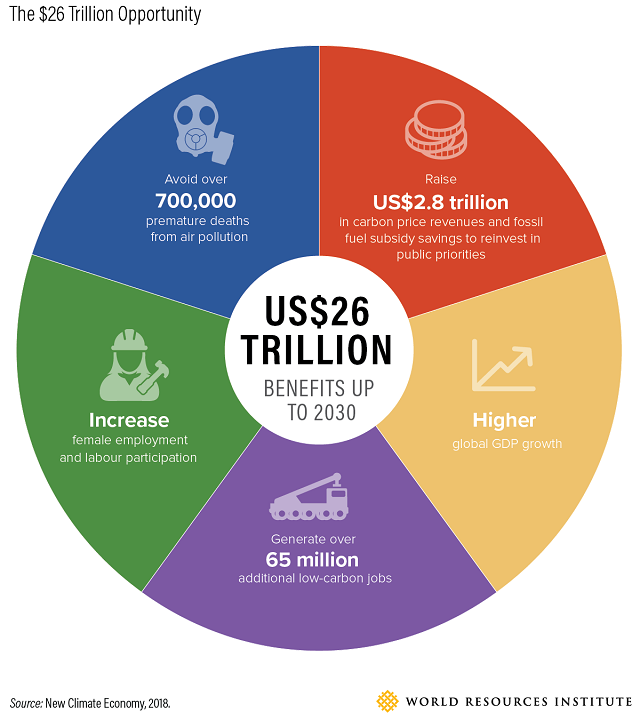
The social and economic benefits of climate mitigation policies include:
- Higher income and living standards. Clean infrastructure investment is a springboard for rapid gains in incomes, poverty reduction and energy access, especially in developing countries, as well as gains in global equity. Rapid innovation and the growing cost-competitiveness of clean energy make it possible to quickly expand infrastructure for energy access without increasing air pollution. Efficiency gains in energy and materials use drive productivity growth, the most important long-term driver of income growth. Adopting the most efficient technologies can lead to large cost savings and translate into lower prices for consumers.
- Employment gains. Cutting carbon emissions increases jobs in green industries while decreasing jobs in high-carbon ones. In 2018, the renewable energy sector employed at least 11 million people worldwide, and is the fastest-growing source of jobs in several countries. Transitioning to a low-carbon economy could deliver up to 65 million new low-carbon jobs by 2030, more than offsetting a decline of 28 million in high-carbon sectors. Such a significant restructuring of labor markets requires strong labor protections to ensure these jobs are decent and pay appropriate wages. Countries will need to implement strong proactive policies to assist and help reskill workers in declining sectors and support economic diversification in highly affected communities.
- Massive gains in public health. Burning fossil fuels creates harmful indoor and outdoor air pollution. The global welfare costs of air pollution were estimated to be about $3 trillion in 2015. Doubling renewables in the global energy mix by 2030 could save up to 4 million lives. Since people with lower incomes are typically more exposed to local air pollution, they may benefit more from its reduction, a gain for social equity. Moving to plant-based diets, which are less carbon intensive, could also yield large public health benefits, particularly in developed and emerging economies where high levels of meat and dairy consumption contribute to poor health outcomes, including high rates of heart disease.
- More social equity. With careful policy design, the poor stand to benefit the most from gains from clean, cheap public transport. Clean infrastructure investments like distributed solar power can also benefit the poor by increasing energy access, lowering costs, and reducing air pollution and health risks. Revenues from carbon pricing and savings from the reform of fossil fuel subsidies can be recycled to better target support to low-income or other vulnerable populations, ensuring they are at least as well off or ideally better off under the policy reforms.
- A healthier natural environment.Many climate policies contribute to a healthier natural environment, for example by reducing deforestation and pollution. Healthier natural environments can better provide ecosystem services, which are the essential support systems for life on earth and the economy. And, most importantly, avoiding environmental damage will benefit all people, but particularly the poor and vulnerable.
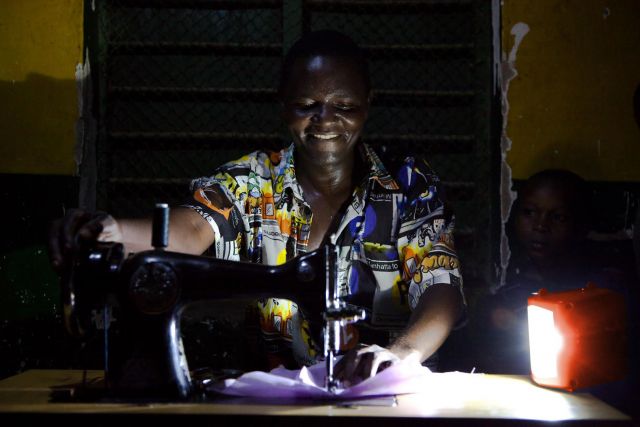
A tailor in rural Tanzania sews at night using a d.light solar lantern. Photo by USAID
People-Centered Climate Action is Possible
Solving the climate crisis in an unequal world will require people-centered climate action: policies that unlock the potential social benefits of climate action; policies that address the needs of low-income and disadvantaged groups and enhance social equity; policies that ensure a well-managed and socially just transition. With these attributes, people-centered climate action can gain the public support and political buy-in required to make significant and lasting change. Climate action that exacerbates inequalities, on the other hand, will not succeed.
There are emerging examples of people-centered climate action in a range of sectors and countries, including:
- In Spain, after intense social dialogue, the government struck a deal with trade unions in 2018 to phase out the country’s coal industry. The plan includes a just transition for coal-producing regions, with the government pledging €250 million ($278 million) over the next decade toward professional training, social protection and new economic opportunities.
- In Canada, the 2019 federal carbon tax will return revenues to households and businesses so that most low- and middle-income households are financially better off with the carbon tax than without it.
- Costa Rica has halted and reversed deforestation while boosting incomes for rural communities. The government implemented a series of progressive, long-term policies, including ending cattle subsidies while paying farmers and landowners for ecosystem services provided by their protected land.
- China established a $15 billion fund for retraining, reallocation and early retirement of the estimated 5-6 million people who would be laid off as a result of eliminating coal or steel sector overcapacity.
- The Kenya-based Green Belt Movement has planted millions of trees on degraded land since the 1970s. It was founded with explicit goals to improve rural women’s lives and livelihoods, responding to their need for water, food, firewood and increased incomes.
Opportunities for People-Centered Climate Mitigation
This section identifies opportunities for people-centered climate action in the key sectors of energy, cities, and food and land use.
1. Energy
Progress in clean energy technologies is transforming our ability to expand access to electricity in ways that also limit air pollution and carbon dioxide (CO2) emissions. This progress is also rapidly reducing costs. Since 2010, solar panel costs have fallen by 85% and wind power by 49%, making clean energy cost-competitive with coal, and increasingly with natural gas, in many regions.
It would now be cheaper to replace three-quarters of existing U.S. coal plants with wind and solar power than to keep them operating with coal. And with falling costs and new developments around battery storage technologies, and integration into the grid, solutions to the variable supply of renewables are emerging.
However, even the more advanced G7 economies on average produce 19% of their electricity from coal, and they provide at least $100 billion per year in subsidies to the coal, oil and gas industries – slowing the market-driven transition. It is time for policymakers and investors to focus on clean energy solutions and stop subsidizing coal.
Despite policy barriers, the deployment of renewables, and the accompanying jobs, is accelerating in many regions of the world. In the U.S. alone, clean energy employs nearly 3.3 million people, outnumbering jobs in the fossil fuel industry 3 to 1. However, these are not always good jobs with decent wages, benefits and rights at work. Governments and employers need to do more to ensure job quality. Some already are.
The Pledge for a Just Transition to Decent Jobs encourages renewable energy developers, producers and buyers to commit to employment standards including social dialogue, labor standards of the International Labor Organization (ILO) and social protection for their employees and those of their contractors. Enel, Ørsted, Autodesk, Safaricom and Unilever are among the companies that have signed the pledge. In the Philippines, the Green Jobs Act of 2016 included provisions on workers’ rights and fair incomes to protect workers in green industries.
Distributed renewable energy systems are quickly creating new opportunities for energy access in developing countries. For instance, in 2017 off-grid solutions provided electricity access to 152 million people, up from 20 million in 2011. Off-grid solar home systems are spreading quickly in some places, offering affordable access to limited amounts of electricity. For example, in many African countries commercial companies are using a “pay-as-you-go” model to rent solar home systems to consumers who use their mobile phones to make payments until they own the system. M-KOPA, one of the biggest companies, estimates that each household saves $650 in avoided kerosene costs over the first four years.
Some clean energy opportunities have spurred an increase in women’s participation in the energy sector. In Nigeria, Tanzania and Uganda, the women-led social enterprise Solar Sister has built a network of over 2,500 women entrepreneurs that provides clean energy services to more than 350,000 people.
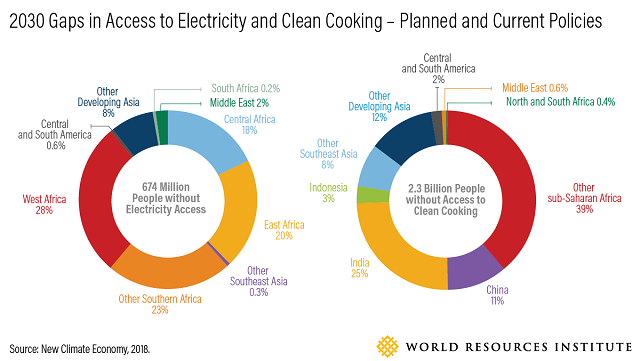
2. Cities
Around 900 million people worldwide live in slums, without adequate access to water, sanitation, power and other infrastructure services. They are often located in far-flung locations exposed to natural hazards.
Compact, connected and clean cities can support inclusive growth and broad-based improvements in quality of life, with major benefits for economic productivity and emissions reduction.
New analysis conducted for the Coalition for Urban Transitions shows that implementing low-carbon measures in cities could support 87 million jobs in 2030 in sectors such as clean energy and public transport. Furthermore, low-carbon measures in cities could deliver over half the emission reductions needed to keep global temperature rise below 2°C.
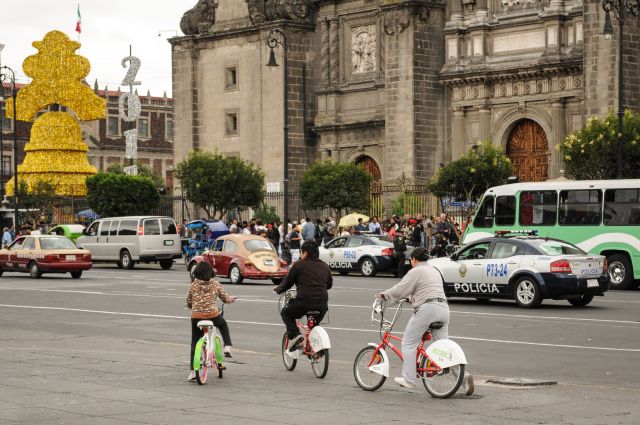
A family on EcoBici public bicycles in Mexico City during a car-free day downtown. Photo by Aaron Minnick/WRI
Agglomeration economies mean that the productivity of workers and businesses is higher in larger, more densely populated cities, particularly those with good public transport networks that enable people to easily reach jobs and services. Greater compactness allows cities to provide infrastructure and services more cost-effectively.
In sub-Saharan Africa, for example, the capital costs of providing piped water, flush toilets, power and landline telephones average $325 per person in the highest-density cities, but $665 in medium-density cities and up to $2,837 in remote rural areas. It is estimated that the low-carbon investments needed to reduce urban emissions by 90% could collectively pay for themselves and then generate a stream of savings worth $23.9 trillion by 2050 in today’s terms.
Higher urban density can also reduce greenhouse gas emissions by cutting transport and residential energy consumption. A recent analysis of 120 cities finds that, after controlling for per capita income, a 10% increase in urban density correlates with a 2% decrease in per capita carbon emissions.
Urban planning and infrastructure policies play a key role in promoting productive urbanization. In their absence, market failures and bad policies, in particular failures to provide critical public goods, often contribute to unmanaged sprawl, lowered economic productivity, growth of slums, over-reliance on private motor vehicles, severe congestion, local air pollution, inefficient energy use, high greenhouse gas emissions, and other negative spillovers.

Urban infrastructure policies that provide for efficient mass public transit systems play a major role in averting many of these dysfunctions, as well as improving social equity by providing low-cost travel for the poor.
In Medellín, Colombia, a cable car system installed in the mid-2000s provided new transport options for slum dwellers living in favelas surrounding the city. The cable car was used by about 30,000 favela residents daily, enabling access to job or education opportunities in the city, while cutting travel times by an hour on average. It contributed to massive declines in violent crime and murders.
In Lagos, Nigeria, a low-cost Bus Rapid Transit system carries 200,000 passengers a day, who enjoy shorter travel times and reduced fares compared to travel on private minibuses. Road congestion and traffic accidents along the route are down, and CO2 emissions have fallen by 13% since 2008.
Similarly in Bogotá, Colombia, the construction of a Bus Rapid Transit system benefited poor residents the most, with poor commuters saving 18 minutes per trip and average $0.50 in daily savings (8-12% of the average daily income for Bogotá’s low-income population).
To “lift all boats” national governments need to proactively plan for a just urban transition, which requires far-sighted collaboration with local governments. For national leaders, creating such cities would yield short-term political dividends and secure long-term national prosperity.
3. Food and Land Use
Improving agricultural practices and land use is a critical aspect of the interrelated challenges of feeding the world, ensuring sustainable rural livelihoods, and addressing climate change. 820 million people are malnourished and regularly go hungry. More than two-thirds of the global poor (more than 500 million people) live in rural areas, where they often experience inequitable access to land and resources, and poor access to markets ‒ which can lead to heavy losses of produce before it’s even sold.
By 2050, the world will need to feed nearly 10 billion people. The difference between the amount of food produced in 2010 and the amount needed to feed nearly 10 billion people is estimated at 7,400 trillion calories. That’s a 56% increase from what we produced in in 2010. But we simply cannot use 56% more land. Instead, we must sustainably increase productivity on current agricultural land to avoid further expansion into natural areas.
A recent report from the Food and Land Use Coalition suggests that key improvements in food and land use systems could indeed improve global food security, while at the same time leading to doubled rural income growth and over 120 million new jobs in poor rural communities. Total economic gains from transforming food and land-use systems could reach $5.7 trillion a year by 2030, linked to reduced greenhouse gas emissions, preservation of natural capital, improved human health, and gains in agricultural productivity and food distribution systems.
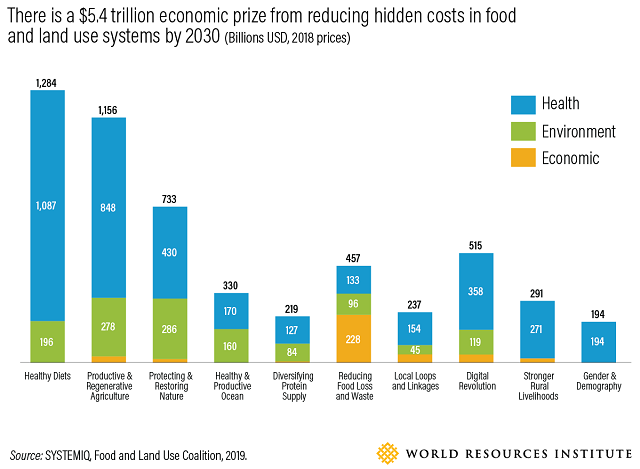
So-called “climate-smart agriculture”’ covers a myriad of old and new production systems, including holistic landscape farming and techniques ranging from intercropping and integrated crop-livestock management to improved water, soil and nutrient management. Done effectively, climate-smart agriculture can lead to higher productivity that creates better jobs and income for farmers, mitigates greenhouse gas emissions, and increases climate resilience.
Farmers in Niger, for example, have adopted improved landscape management approaches, greatly increasing tree and shrub cover on cropland by interplanting nitrogen-fixing trees and allowing roots and stumps to regenerate. The strategy has substantially increased productivity on 5 million hectares (12.4 million acres) of land, restored at least 250,000 hectares (617,763 acres) of severely degraded land, and provided food for 2.5 million people.
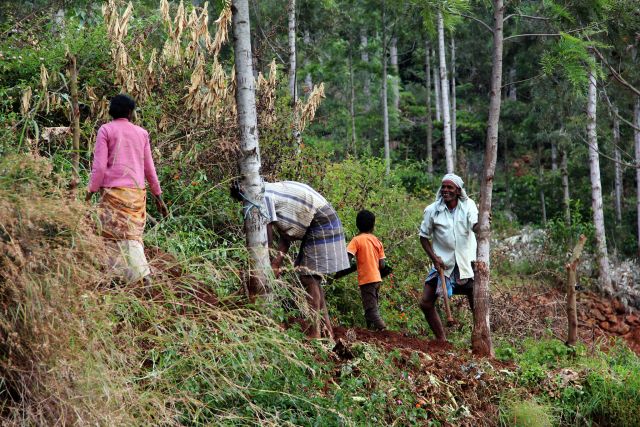
Villagers in the Nilgiri Mountains of India practice agroforestry, a form of climate-smart agriculture that mixes crops with the native trees. Photo by James Anderson/WRI
Higher productivity on existing lands reduces the pressure to clear forests. Forests generate multiple social and economic benefits, including improved soil quality, habitat for biodiversity, and regulation of local and global climates. Forests support a variety of industries, from fiber production to ecotourism.
Protecting forests can go hand-in-hand with protecting people. In Bolivia, Brazil and Colombia, areas managed by indigenous people with secure land rights had two to three times less annual deforestation from 2000-2012 than similar areas of those countries not managed by indigenous people.
A shift to healthy plant-based diets can also have enormous benefits for people and also for the climate. Shifting the diets of populations who consume high amounts of animal-based foods toward plant-based foods could result in global health-related cost savings of almost $1 trillion per year by 2050, as well as avoiding future emissions related to changing land use by 37-168 gigatons of equivalent Co2 (GtCO2e).
Opportunities for People-Centered Climate Adaptation
Reducing greenhouse gas emissions is essential to avert the threat of catastrophic climate change. Yet historic emissions have locked in some global warming and climate change is exacting large human and economic costs through heatwaves, floods, drought, storms and other extreme weather events.
Recent analysis by the Global Commission on Adaptation indicates that an investment of $1.8 trillion between 2020 and 2030 could yield benefits of $7.1 trillion over this period. These benefits include avoided losses to farmers’ livelihoods, to workers’ jobs and wages; avoided damage to homes, businesses and infrastructure; and avoided deaths, trauma and illness.
Climate adaptation can especially benefit the poor, who tend to live in areas more exposed to natural hazards like landslides or flooding. The social gains of adaptation will be greater and more equitable if poor and vulnerable populations participate in the planning and design of public policies, contributing unique local knowledge and voicing their specific needs. Five areas of action should be prioritized to strengthen the resilience of our communities and systems to climate change and, in some cases, also contribute to reducing emissions:
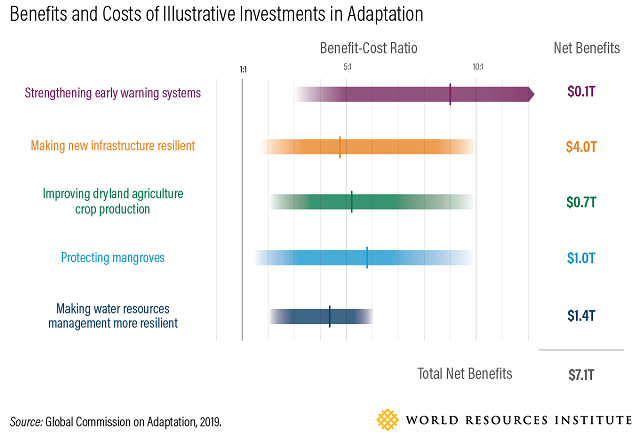
1. Strengthen early-warning systems
Flooding affects 250 million people each year, with around 84% of floods occurring in developing countries. Floods cause an average of 5,000-6,000 deaths annually and overall economic costs from deaths and direct and indirect economic damages have been estimated to exceed $70 billion per year, with over 80% of these costs in developing countries.
Meteorological early-warning systems, alongside critical infrastructure (e.g., roads and bridges used for evacuation), and environmental buffers (e.g., mangrove forests that protect coasts from storm surges) can mitigate much of the damage from natural disasters. Early warning of an approaching flood gives people time to move to safer ground, allows authorities to help the most vulnerable, and enables businesses to protect property and infrastructure.
Studies suggest that a 24-hour warning can reduce asset damage from floods by around 30%, and a 48-hour warning by up to 50%. Investments to upgrade early-warning systems, especially in developing countries, are expected to have a high benefit-cost ratio: a $10 billion investment would yield benefits of around $100 billion between 2020 to 2030.
In Bangladesh, better early warning systems ‒ combined with civic awareness campaigns, cyclone shelters, strengthening buildings and improving post-disaster recovery ‒ have dramatically reduced deaths from cyclones: 300,000 people died from Cyclone Bhola in 1970, but only 5 in the entire country died from Cyclone Fani in 2019.
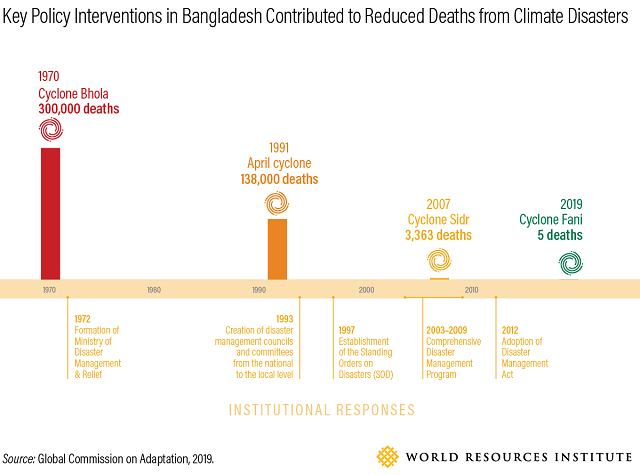
2. Protect mangrove forests
Mangrove forests extend along 700,000 kilometers (roughly 435 ,000 miles) of coastline in 123 countries, forming a natural seawall that limits damage from flooding. Worldwide, mangroves reduce the cost of damage to property from coastal flooding by over $80 billion per year, while reducing the number of people affected by coastal floods by 18 million. Other services provided by mangroves include the provision of raw materials and food for coastal communities, nurseries for offshore fisheries, and recreation opportunities. The benefits of mangrove preservation significantly outweigh the value of forgone opportunities such as aquaculture.
3. Improve dryland crop production
Dryland farming refers to farming that relies entirely on rainfall, undertaken in relatively dry areas of the world. Drylands cover 41% of the earth’s surface and are home to 30% of the human population, including the majority of the world’s poor.
Dryland agriculture typically produces low and variable yields, because of low and erratic rainfall, high temperatures, poor soil quality and land degradation, especially in developing countries. In sub-Saharan Africa, crop productivity per unit of water consumed is only 20-40% of the world average. Climate change will likely exacerbate the challenges of dryland farming in sub-Saharan Africa, with even higher temperatures, more erratic rainfall, and more extreme weather events reducing yields by 10-15%.
Investments to increase the adoption of modern farming technologies and practices optimized for dryland conditions could significantly help poor smallholder farmers in developing areas better adapt to climate change, increasing incomes and slashing poverty. Methods include greater uptake of new crop varieties that provide higher yields with limited water, improved soil management, and more efficient water management. Such interventions could boost cereal yields in sub-Saharan Africa by 70-140%. Globally, investing $150 billion in dryland agricultural productivity from 2020 to 2030 could generate net economic benefits of over $850 billion.
4. Manage water resources
The impacts of climate change are channeled primarily through the water cycle. Improved water management can help countries better adapt to water scarcity and more variable supply. Water service providers have traditionally relied on “gray” or built infrastructure, such as dams and water treatment plants. Today the water management sector draws increasingly on “green” infrastructure such as forests, farms and floodplains that can increase the quantity and quality of water downstream.
The returns for investing in water resource management can be substantial, especially for green infrastructure. New York City’s efforts to protect its watershed have cost $1.5 billion since the 1990s but have averted the need to build new water treatment facilities costing $8 billion, yielding a benefit-cost ratio of 5:1.
Green infrastructure is likely to have substantial co-benefits, including carbon sequestration, reduced air pollution and improved health, healthier ecosystems and recreation opportunities. Better planning and incentives could dramatically improve the efficiency of water use. The World Bank estimates that by 2050, policy reforms in water resource management could increase developing regions’ GDP by 8–20% relative to a business-as-usual scenario.
A participatory approach can ensure that individual people and families benefit. In Togo, the government and civil society organizations engaged local women and youth in developing an ecosystem-based project to revitalize water reservoirs and build climate resilience. The project improved crop yields and created new livelihood opportunities like market gardening, fisheries and brick construction, all stemming from greater water availability and security.
5. Build resilient infrastructure
Any disruptions to power, transport, water and other infrastructure systems exact heavy costs on households and businesses. The economic damages to households and businesses in low- and middle-income countries from disruptions of power, transport and water systems are estimated at $391-647 billion annually.
In 2007, Tropical Storm Sidr knocked out the entire power grid of Bangladesh, leaving the country’s population without power for up to a week and causing $1.7 billion of economic losses. In Tanzania, firms suffer losses equal to 1.8% of GDP annually due to power, transport and water disruptions, of which 40% are caused by rain and floods.
Improving the resilience of infrastructure requires action at several levels. Physical assets such as roads, power lines and bridges need strengthening to resist natural hazards. Recent studies estimate that improving the climate resilience of new infrastructure assets typically costs 2-5% of the total cost of the assets. The cost of such investments would be about $1.1 trillion from 2020 to 2030. The benefits include both avoided damage to physical infrastructure and avoided costs of infrastructure disruptions for households and businesses. The present value of such benefits over the lifetime of this resilient infrastructure is estimated at around $5 trillion, giving a 5:1 ratio of benefits to costs.
A New Decade Demands a New Approach
Policymaking can be painstaking and slow. Good policymaking can be even slower. The trials of the process often cause ministers and decision-makers to rely too heavily on input from interest groups with enough power and access to make their voices heard.
In many cases, these vested interests have pushed back against climate action and in favor of the status quo. As the transition progresses, the political and policy grip of the fossil fuel industry and others blocking change will wane.
To succeed, the global transition to a new climate economy needs to be people-centered and offer the prospect of a fairer world. If it does, more and more people will see their future in it and will support change.
We have not seen the end of the social unrest that erupted in 2019. But 2020 provides leaders with a unique opportunity to train their gaze and focus on social benefits, enhanced equity and a just transition, as countries revise their climate plans and scale up implementation.
We know how to develop smart climate programs and policy reforms that improve people’s lives and livelihoods immediately, while safeguarding development gains and economic growth into the future. We can, and must, get these programs and reforms right. The people are watching.
This commentary was originally posted on WRI’s Insights.
Helen Mountford is the Vice President for Climate and Economics at World Resources Institute.
Sarah Colenbrander is the Head of the Global Programme at the Coalition for Urban Transitions.
Carter Brandon is a Senior Fellow for the Global Commission on Adaptation.
Edward Davey is Director of the Geographic Deep Dives of The Food and Land Use Coalition.
Jessica Brand is Communications Manager for the New Climate Economy.
Delger Erdenesanaam is Communications Specialist at World Resources Institute.






